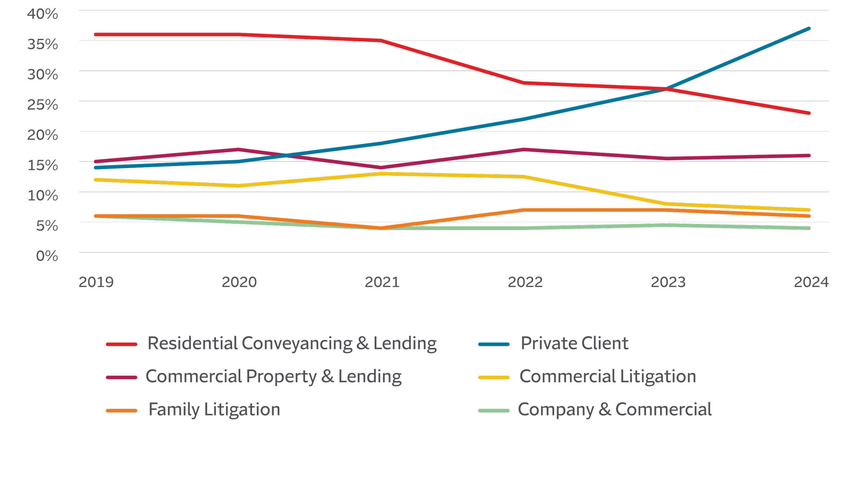To Manage Negligence Risks, Law Firms Can Minimise Distraction


When Travelers reviewed negligence-related insurance claims for law firm clients over the past six years, some surprising results emerged.
First, over half of claims came from two areas: residential conveyancing; and private client work, which involves wills, trusts and probate. The presence of residential property claims wasn’t a shock, considering this work is a common driver of negligence claims. But in recent years these claims have decreased in number; however, severity is increasing.
“The current share of residential conveyancing claims is lower than it has been for some years,” said Paul Smith, senior risk management consultant at Travelers Europe. “One probable reason is that we haven’t seen a shock to the system like a property market crash since around 2008. That said, conveyancing still generates a significant number of claims, and their cost is increasing. For example, claims brought by aggrieved purchasers, unhappy about paying more tax due to missing SDLT deadlines, are more frequent and cause an uptick in claims activity.”
Increased risk for estate-related work
Conversely, negligence claims involving wills, trusts and probate have been climbing markedly over the time period Travelers studied. They now generate over one-third of notifications, which is also unusual.
“We may be seeing the results of an aging population and rising numbers of people diagnosed with dementia, for example,” Smith explained. “This generates concerns around mental capacity and suspicions of undue influence when making wills. The unprecedented rise of remote engagements during the COVID years also created significant barriers for getting wills and documents signed and witnessed in person. If you’re an aggrieved beneficiary or believe you should be a beneficiary but are not, it can be tempting to lawyer up.”
Trends by work area: Frequency by year of notification from 2019 to 2024

Common errors drive negligence claims
What’s behind these claim trends? For both work areas, retainer management is an error hotspot. It generates the greatest volume of claims, eclipsing errors involving advice, drafting or dishonesty. Issues may result when clients feel their lawyer hasn’t followed clear instructions, has provided inadequate professional service, or has missed time limits, for example.
Distraction drives these claims. Often, stress, fatigue and burnout are behind it.
“We suspect this trend correlates with the increasing use of technology in our personal and work lives,” said Philippa Wilkin, senior risk management consultant at Travelers Europe, where she studies law firm culture. “Multiple technologies can make it more likely for people to miss something or make mistakes that might be catastrophic at some point in the future.”
Evolving risks to mental health
The risks of distraction stand to increase as law firms adopt more technology – and feel pressure to work better, faster, and more efficiently to serve clients. There is also risk in defaulting to technology to manage mental health in this environment.
“Dealing with stress and mental health isn't just giving people another app for meditation,” Wilkin said. “This profession is under significant stress from the moment they come out of the blocks. Often it gets to the point of burnout to recognise there's a problem.”
So, it’s important for firms to address mental health concerns before they balloon into larger risks – both to the health of the employee and to the financial and reputational health of the firm.
Stopping the unintentional drift toward risk
Jens Rasmussen, a researcher in safety science, human error and accidents, studied how organisations respond to the kinds of challenges law firms experience today. He found that when faced with pressure to control costs, increase productivity, and maintain safe practices, organisations can unintentionally drift toward unsafe practices.1 This gradual shift often goes unnoticed until an incident occurs. People naturally adapt their behaviors to meet goals while believing they are operating within safe limits – even when they are not.
For example, this can occur in law firms when it takes lawyer burnout to change an unsafe work environment. Client demands, tight deadlines, and billing targets – whilst normalised in the industry, may push the boundaries of what is safe and effective when it comes to human capability.
Organisations can operate more safely when they identify the pressures they face and establish monitoring systems that detect signs of unsafe drift. This requires having clear policies, effective training, and a culture that encourages its people to report mistakes and concerns without fear of blame.
“Having a risk-aware culture involves learning from near misses and anticipating possible outcomes, as well as honouring circadian rhythms and creating a work environment that helps people succeed,” Smith said. “When law firms proactively manage their risks in these ways, they become much more resilient in the face of complex challenges.”
As firms face pressures to find and retain the best talent, keep pace with clients’ needs, and integrate technology that is reshaping the sector, proactive risk management becomes even more important.
“It’s why we are actively researching the connection between stress and negligence at Travelers right now,” Wilkin said. “We want to help firms reduce their risks and enhance their workplace culture so they can be safe, thriving businesses.”
This article highlights insights from Travelers’ ‘Solicitors Portfolio Risk Analysis – Spring 2025 Report’. To view the full report, exclusively available to Travelers PI policyholders, please click here.
This article is provided for general informational purposes only. It does not, and it is not intended to, provide legal, technical or other professional advice, nor does it amend, or otherwise affect, the provisions or coverages of any insurance policy issued by Travelers.
Travelers operates through several underwriting entities in the UK and Europe. Please consult your policy documentation or visit the websites below for full information.
Source:
1 https://risk-engineering.org/concept/Rasmussen-practical-drift



